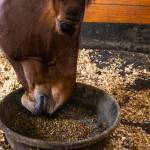Feed Storage Tips

Proper storage of hay and grain can save time and money. A recent article by Pat Barnhart in Trail Blazer provides insight into how properly stored feedstuffs can help protect horse health.
Concentrates are an important part of many rations. Barnhart recommended horses owners buy enough grain to last no longer than about 10 days. Feed stored for longer periods will begin to lose its nutritional value. In order for feed to retain its freshness, storage facilities should be kept cool, dry, and pest-free. Storage containers such as garbage cans with tight-fitting lids can help keep grain safe from elements and rodents.
Plastic containers are preferable to metal ones because they are less likely to produce condensation. John Burton, Ph.D., a recently retired professor of equine nutrition at the University of Guelph in Ontario, Canada, said in The Horse, “If warm air comes in contact with cold metal, moisture will form.” This moisture could produce mold, according to Burton.
Recycling old chest freezers or specialized livestock feeding bins is another storage option. All storage bins, regardless of the source or type, should be cleaned before being used and maintained on a regular basis. Feed rooms should be well lit and locked in case a horse gets loose.
Hay also requires proper storage and care. All hay should be stored out of nature’s way, including being kept off of the ground to protect it from any moisture. Even hay that is kept inside can wick moisture from the ground, which can allow mold to grow. Hay stored outside should be protected from the weather in order to maintain its nutritional quality.
If you have questions about feed and hay storage, seek the advice of an equine nutritionist.








